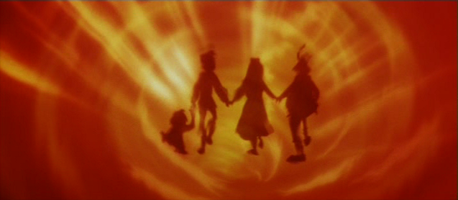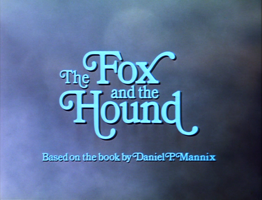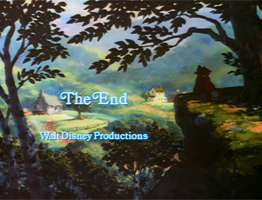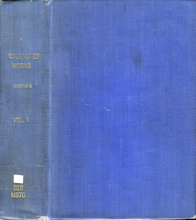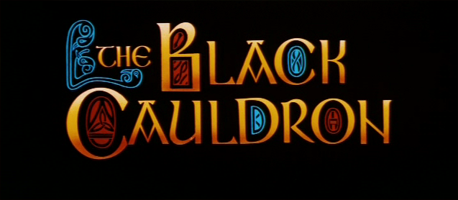
ADAM That felt like a He-Man cartoon.
BETH Yes, but a pretty nice one.
ADAM It felt like a He-Man two-hour special.
BROOM It was higher budget than He-Man ever was; it was the content that felt similar.
ADAM Do you remember Skeletor?
BROOM Of course. The horned king looked exactly like him. Which came first?
BETH Skeletor was earlier.
ADAM It also had the feel of an eighties cartoon in that the backgrounds felt like watercolor and the action felt like shrinky-dinks, pasted on.
BETH The backgrounds were a lot nicer than I thought they would be. I was really expecting this movie to be a lot uglier.
BROOM Chintzier.
BETH “Chintzier,” yes, because actually it was really ugly; or at least it had a lot of ugly things in it. And scary things.
ADAM Right, just like Snow White. I mean, we like that.
BETH Yes, but it was scarier than Snow White.
BROOM It wasn’t scary in an old warm-hearted “being scared is fun” way. It was scary in an 80s way.
ADAM Like, Freddy Krueger scary?
BROOM Sort of a Steven Spielberg scary — like Poltergeist. Or like Raiders of the Lost Ark, which it was very much like. It was! The effects around the cauldron were almost the same. The plot was really very similar. Except for the pig.
ADAM The pig was more like Frodo Baggins.
BROOM No it wasn’t!
ADAM No, it wasn’t, but the plot did feel like a Lord of the Rings knock-off.
BROOM There had been that Lord of the Rings animated movie in the 70s, right? I think that other people had beaten Disney to this world of adult, “serious” fantasy animation., and here Disney was venturing in that direction. It was certainly very different from anything that had come before. We’re really in an entirely different cultural territory here.
ADAM It was sort of charming. I mean, all eighty minutes I was awake. There were always things happening; there were no digression caterpillars.
BETH That’s true.
BROOM Yes, but it was confused about drama. A lot.
ADAM Yes: it had the climax in the first twenty minutes, and then it just kept climaxing and climaxing.
BROOM What would you say was that early climax?
ADAM When they escaped from the castle.
BROOM I guess. I basically understood what the progression of events was supposed to be, in the scheme of a movie like this. I meant more that there were a lot of sequences where the tone was confused, or where the music was a little confusing. Like, it was dark and foreboding right at the beginning, when he was still just innocently playing in the Shire. And then it was gloriously magical when they were basically meeting the Smurfs. Those weren’t the right choices.
BETH Was this rated G? That woman’s boobs, and all the beer and wine…
BROOM It was PG. But even so, the degree of horror still seemed high. The horned king’s face coming at you, and all the evil magic effects. It was really an effects-oriented movie.
ADAM They really did an excellent job on the green ectoplasm coming out of the cauldron. It was like Ghostbusters ectoplasm.
BETH All the special effects seemed lovingly done, like the backgrounds. The layouts, too — the actual design of the shots.
ADAM The way that the Fair Folk glowed.
BETH I thought that was really nice and atmospheric.
BROOM There were a lot of backlighting effects like that. The movie was really an effects showcase, whereas there have been almost no effects in any of the recent movies. Just one movie ago, in The Fox and the Hound, it really felt like they were trying to get through with the least possible animation, whereas here — uniquely, for the first time in several decades — it felt like the animators were doing something that they found exciting. Which is not to say that the final product was so great, but it certainly felt enthusiastic.
ADAM I had that feeling some in The Rescuers.
BETH Really? When?
ADAM I don’t know, in the swamp.
BETH With that, I thought they might have been having some fun but they weren’t necessarily really into it.
ADAM So what would you say was the last truly excited animation? Sleeping Beauty?
BROOM Yes, I think that might be it. And this movie had some things in common with Sleeping Beauty.
BETH The princess kind of looked like Sleeping Beauty.
BROOM This was the first time we’ve seen those really big 80s eyes.
ADAM They had a sort of manga quality. You know who she reminded me of? Luna Lovegood.
BROOM Because she didn’t pay any attention to what he was saying? What did her magic bauble do? What function did it serve? And also, where did it go?
BETH It was there at the end.
ADAM It abandoned them in the middle, but then it came back. This was fine. I totally would have enjoyed watching this as a kid: it had a lot of plot, and I wouldn’t have minded the failure of characterization.
BETH I would have needed to be at least nine.
BROOM I would have been too scared as a little kid.
ADAM I would have liked Gurgi just fine. Even though he was a real sniveling sycophant weirdo. I don’t think he deserved to be redeemed just because he killed himself.
BROOM What is the deal with that character archetype? Which as we said many times during the movie, is Jar-Jar Binks and Dobby, and obviously some relation to Gollum, too. It’s some kind of horrible slave-idiot stereotype, right? They always call the hero “master” and can’t speak good English.
BETH What was the first one?
BROOM It’s some kind of modernization of…
ADAM It’s sort of Stepin Fetchit.
BROOM Yes, that’s it. So why is that here? Do kids like that? Is it simultaneously supposed to be sort of like a kid?
BETH Yes, I think kids can relate.
ADAM Kids can laugh at that and feel superior to that.
BROOM I found it very hard to understand what he was saying.
ADAM I really liked making that voice as a kid! It was really annoying to everyone else.
BROOM There was definitely a lack of characterization, like you said. And it was an all-gimmickry plot — we kept saying how it was like a video game. But it did have a force of conviction behind its superficiality.
BETH I was expecting it to be worse than the worst that we’ve seen, and it was much better than that. It wasn’t the worst by far.
ADAM Not even in the bottom quarter.
BROOM You started off the conversation about The Fox and the Hound by saying that the only thing wrong with it was that it was all clichés. I daresay this was all clichés as well! A different set of clichés that we see far more often, in fact.
ADAM But it wasn’t the same kind of clichés.
BROOM I know! It was a whole new stock of clichés. Like you said, the same stock drawn on by He-Man, which was all about clichés eating each other. And in the course of this series, that change in type was refreshing to us. But I think that’s just because right now this set of clichés happens to feel new, not because these clichés are any more worthwhile. I think in the long run they’re probably less worthwhile.
[we read the New York Times review but by the time we’re done, we’re already gearing up to watch the State of the Union and have lost focus]
